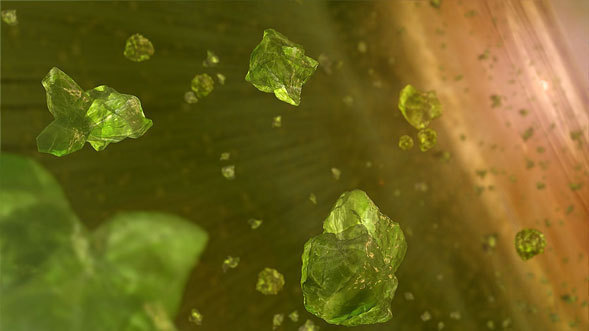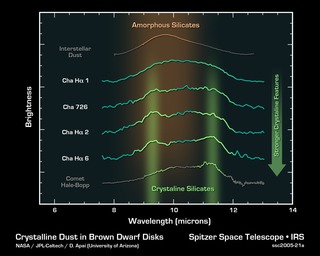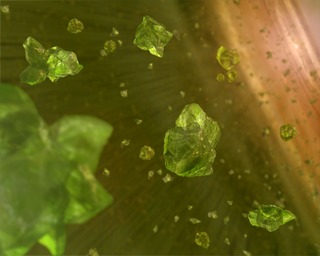
Credit: NASA/JPL-Caltech/D. Apai (University of Arizona)
Chart • October 20th, 2005 • ssc2005-21a
ssc2005-21a
This graph of data from NASA's Spitzer Space Telescope shows the spectra (middle four lines) of dusty disks around four brown dwarfs, or "failed stars," located 520 light-years away in the Chamaeleon constellation. The data suggest that the dust in these disks is crystallizing and clumping together in what may be the birth of planets.
Spectra are created by breaking light apart into its basic components, like a prism turning sunlight into a rainbow. Their bumps represent the "fingerprints" or signatures of different minerals.
Here, the light green vertical bands highlight the spectral fingerprints of crystals made up primarily of a green silicate mineral found on Earth called olivine. As the graph illustrates, three of the four brown dwarfs possess these microscopic gem-like particles. For comparison, the spectra of dust between stars (top) and the comet Hale-Bopp (bottom) are shown. The comet has the tiny crystals, whereas the interstellar dust does not.
The broadening of these spectral features or bumpsseen here as you move down the graphindicates silicate grains of increasing size.Another analysis of this same data shows that some of the brown dwarfs' dusty disks flare in their outer regions, while others are flattened. This flattening is correlated with increasing grain size, and probably occurs because the heavier dust grains are settling downward.
Together, these observationsof crystals, growing dust grains and flattened disksprovide strong evidence that the dust around these brown dwarfs is evolving into what might become planets. Prior to the findings, these first steps of planet formation were seen only in disks around stars, the brighter and bigger cousins to brown dwarfs.
About the Object
- Name
- Type
- Star > Type > Brown Dwarf
- Star > Circumstellar Material > Disk > Debris
- Distance
- 520 Light Years
Color Mapping
| Band | Wavelength | Telescope |
| Infrared | 7.5 µm | Spitzer IRS |
| Infrared | 13.0 µm | Spitzer IRS |






